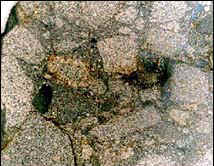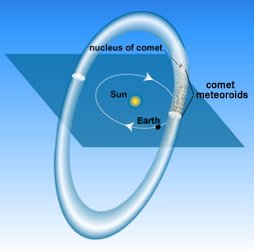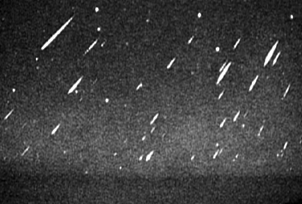|
By now you know a lot about comets:
where they come from, what they're made of, what they look like, and
why they look that way. But there are other objects in space that
are not planets or moons. What do comets have in common with
them? How are they different? For example:
Are Comets and Meteors the same thing?
Have you ever seen a shooting star? Shooting
stars are also called meteors,
and we know that they are not stars at all. In fact, they look like
very fast moving comets. A meteor may in fact have once been part of a
comet.
As a
comet travels near the Sun, developing its coma
and dust tail, it can lose several hundred million tons of dust and vapor. The closer it gets to the Sun, the more solids and gases are released. This material remains in orbit about the Sun, and the solid pieces themselves are called meteoroids. A
meteoroid becomes a meteor when it falls through the atmosphere, and we
see it shoot across the sky.
| Most of the
meteors left behind by comets are very small.
These small objects hurl through the atmosphere so fast that they heat
up and actually burn very brightly. This is similar to what happens to
spaceships as they re-enter the atmosphere --they get very hot, and the
astronauts must be protected from the heat. Most meteoroids are
completely burned up in the earth's outer atmosphere. But every
now and then, large meteors make it all the way to the
groundóthen they are called meteorites. |



|
Meteor Showers:
space weather from comets
| When Earthís orbit passes through a trail
of comet debris, there are many meteors visible in a single night--a
meteor shower. The Earth passes through the meteoroids from the comet
in the same place each year as it goes around the Sun, so meteor
showers occur annually. For example, every August we can see the
beautiful Perseid meteor shower, caused by the dusty trail that Comet
Swift-Tuttle left behind.
|
 |
|

Photo by Lorenzo Lovato
|
The picture of the Leonid Meteor shower to the right was taken in 1998 from an airplane. The Leonid meteors appear every November, and seem to come out of the constellation Leo, the lion. They are pieces left behind by comet Tempel-Tuttle.
|
Are Comets and Asteroids the same thing?
 Asteroids
are sometimes called minor planets. They are small, rocky worlds.
Most of them orbit the Sun between Mars and Jupiter in what is known
as the asteroid
belt. Since they are not made of frozen gases
like comets, asteroids donít form a coma of bright, heated gas.
Since they donít have a coma, they canít form glowing plasma tails
or dust tails that reflect light. Asteroids are very difficult to
observe, even with a telescope, because they reflect only tiny amounts
of sunlight, but they are now being studied using satellites. Asteroids
are sometimes called minor planets. They are small, rocky worlds.
Most of them orbit the Sun between Mars and Jupiter in what is known
as the asteroid
belt. Since they are not made of frozen gases
like comets, asteroids donít form a coma of bright, heated gas.
Since they donít have a coma, they canít form glowing plasma tails
or dust tails that reflect light. Asteroids are very difficult to
observe, even with a telescope, because they reflect only tiny amounts
of sunlight, but they are now being studied using satellites.
|






